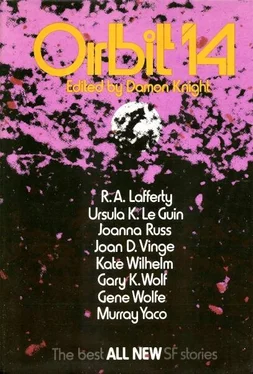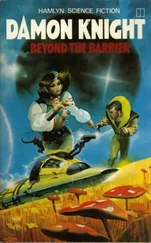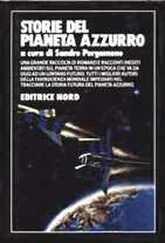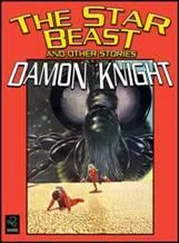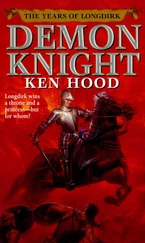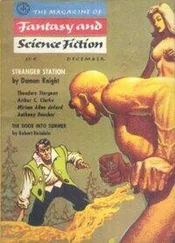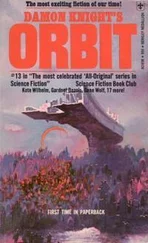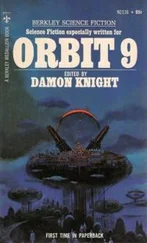Damon Knight - Orbit 14
Здесь есть возможность читать онлайн «Damon Knight - Orbit 14» весь текст электронной книги совершенно бесплатно (целиком полную версию без сокращений). В некоторых случаях можно слушать аудио, скачать через торрент в формате fb2 и присутствует краткое содержание. Год выпуска: 1974, ISBN: 1974, Издательство: Harper & Row, Жанр: Фантастика и фэнтези, на английском языке. Описание произведения, (предисловие) а так же отзывы посетителей доступны на портале библиотеки ЛибКат.
- Название:Orbit 14
- Автор:
- Издательство:Harper & Row
- Жанр:
- Год:1974
- ISBN:0-06-012438-5
- Рейтинг книги:4 / 5. Голосов: 1
-
Избранное:Добавить в избранное
- Отзывы:
-
Ваша оценка:
- 80
- 1
- 2
- 3
- 4
- 5
Orbit 14: краткое содержание, описание и аннотация
Предлагаем к чтению аннотацию, описание, краткое содержание или предисловие (зависит от того, что написал сам автор книги «Orbit 14»). Если вы не нашли необходимую информацию о книге — напишите в комментариях, мы постараемся отыскать её.
Orbit 14 — читать онлайн бесплатно полную книгу (весь текст) целиком
Ниже представлен текст книги, разбитый по страницам. Система сохранения места последней прочитанной страницы, позволяет с удобством читать онлайн бесплатно книгу «Orbit 14», без необходимости каждый раз заново искать на чём Вы остановились. Поставьте закладку, и сможете в любой момент перейти на страницу, на которой закончили чтение.
Интервал:
Закладка:
There is no one discipline that covers all the possible effects of a new dam or irrigation system. Engineers and politicians build it; biologists and economists are called in later, if at all. Engineers are often aware that irrigation now will call for drainage later, but in order to get their projects approved they are willing to leave that for the next generation.
Another factor is cited by Michel Bâtisse: 3 3 Director of the Natural Resources Research Division of UNESCO in Paris.
“There is a kind of convergence of interest in what I might call the ribbon-cutting complex where you want to have the president of the republic come with scissors and cut a red ribbon, issue a postal stamp and so on. It has to be a very big structure; otherwise, it is not interesting.” 4 4 The Aswan High Dam has seventeen times the volume of the Cheops Pyramid.
All over the world, massive projects undertaken with the best of intentions are backfiring lethally. New roads, built where it is easiest to build them, bring colonists to virgin land unsuitable for cultivation: the results within a few decades are “rural slums, ecological disaster areas.” Large mechanized agricultural projects, particularly monoculture, drive people off the land and into cities, where they add to the unemployed. “In Algeria, by government’s admission, unemployment rates are something on the order of 50 per cent.”
Here is an arresting statement from John Cairns, Jr.: 5 5 Research professor of zoology at the Virginia Polytechnic Institute and State University.
6 6 Professor of soil science at the University of Reading, England.
“The agriculture industry has probably been responsible for more pollution than any other single industry. This is so primarily because regulatory agencies are mostly looking at point sources of pollution and not particularly at dispersed and intermittent pollution.” Here is another from E. Walter Russell:® “Sulfate of ammonia is, I suppose, the most dangerous fertilizer used in Africa, because it makes such large demands on the calcium supplies of the soil, and in most of Africa the calcium supplies are very low. . . . It is unfortunately now a by-product of nylon manufacture, and the manufacturers have to get rid of the stuff, so it is cheap.”
The Careless Technology is 1,030 pages long, and large parts of it are dry. It should be widely read, nevertheless, for its survey of what might be called second-stage technological failures—disasters brought about by our efforts to avert disaster.
If some of these papers are heavy going, the discussions that follow each section are compellingly readable. Here is an edited sample:
KASSAS 7 7 Mohammad Abdul Fattah Kassas, professor of applied botany at the University of Cairo.
: The second point I would like to make concerns the impact of bilharziasis (schistosomiasis) on the human population. We can say that Egypt has a population that has lived with bilharziasis for thousands of years. Bilharziasis eggs were discovered in ancient Egyptian mummies dated to the second or third dynasties. We might say at the minimum, then, that the Egyptians as a population have failed in several thousand years to eradicate and rid themselves of bilharziasis. But I can look at this fact another way and say that the Egyptian has managed to live with bilharziasis and bilharziasis has failed to eradicate Egyptians for thousands of years. In Dr. van der Schalie’s paper, we are told that bilharziasis kills one out of every five people who die in Egypt. I wonder whether it is more painful to die of bilharziasis or die of hunger. I believe it is more demoralizing to die of hunger than to die of bilharziasis.
FARVAR 8 8 Mary A. Farvar, an anthropologist at Washington University, St. Louis, Missouri.
: Unfortunately for the peasants in the countryside they are the victims of schistosomiasis. These are also the people who produce the “food” which urban people consume. Thus, assuming that irrigation and technological development are indeed used to produce more food, we have the urban dwellers who make the decision to exchange food (for themselves) with disease (for the peasants). Naturally, from the point of view of the urbanite it is more demoralizing for him to die of hunger than for the peasant to die of schistosomiasis. The actual situation is even worse because the irrigation and the technology are not even used to produce food [so much] as they are to produce cash crops like cotton, and electricity (again for the enjoyment of the city people). How much should the peasants have to.suffer in order to fulfill the whims of those who are ruling them from the cities? Who asks the peasants what price they are willing to pay? And when the cost is finally pointed out, the answer is invariably: “The solution is being field-tested just around the comer!”
MYRDAL 9 9 Gunnar Karl Myrdal, professor of international economics at the University of Stockholm.
: Do you agree with my fundamental assumption for all development thinking: that we have a moral imperative to do our best to cure illnesses and prevent premature death?
BOULDINC 10 10 Kenneth E. Boulding, professor of economics at the University of Colorado.
: No. I think death is absolutely essential to mankind. The greatest disaster that the human race could ever face is immortality. By the time our molecular biologists are finished, they may find out what it is that creates aging and tweak it out. This would be an unprecedented and unspeakable disaster.
I recommend this book particularly to science fiction writers, for the overview it gives of the world’s present and near-future problems, and also (a by-product) for the opportunity to eavesdrop on real scientists and observe how much more intelligent, more interesting, and more human they are than their fictional counterparts.
Billion Year Spree by Brian W. Aldiss (Doubleday, 1973, $7.95)
Imaginary Worlds by Lin Carter (Ballantine, 1973, $1.25)
In these two books Brian Aldiss and Lin Carter have almost but not quite parceled out the history of imaginative fiction between them. Aldiss takes s.f. for his portion (from Mary Shelley onward). Carter claims the rest, i.e. fantasy, but in fact his subject is a subgenre, the dream-world story, stemming from Eddison and Howard. Between them falls the great bulk of fantasy writers, from Algernon Blackwood to Italo Calvino: even so, there are places where the two schemata interestingly overlap. Carter praises the invented place-names of Lovecraft; Aldiss mocks them as “anagrams of breakfast cereal names.” Carter calls A. Merritt “an absolute master of the adventure fantasy”; Aldiss writes: “Merritt’s overheated style exactly matched his plots, which were up to here in serpents, feathers, fur, great black stallions, freaks, naked women, evil priests, golden pigmies, talismen, monsters, lovely priestesses, sinister forces, and undefined longings.” Carter praises William Hope Hodgson’s The Night Land; Aldiss finds it unreadable. Carter calls William Morris’s The Wood Beyond the World “the first great masterpiece of the imaginary-world tradition”; Aldiss reports that the novel “belongs to the tushery school (‘She said, in a peevish voice: “Tush, Squire, the day is too far spent . . .” ’).”
These examples sufficiently show the very different positions from which the two writers begin; nevertheless Aldiss and Carter are both aficionados, and these books are labors of love.
Aldiss postpones his discussion of Lucian, Cyrano & Co. (he calls them “the Pilgrim Fathers”) in order to begin his narrative with Erasmus Darwin, Charles Darwin’s grandfather, whose influence on s.f. he traces from Erasmus’ long poem The Temple of Nature, published posthumously in 1803, through Erasmus’ contemporary William Godwin, author of Caleb Williams, to Godwin’s daughter Mary, who wrote Frankenstein. Aldiss considers this work “the first real science fiction novel” (although he quotes Wells, who said the monster was animated by “jiggery-pokery magic”). Because it is a Gothic novel, and because there are undeniable traces of Gothic in later s.f., Aldiss has been tempted to propound a theory (which some may think perverse) that science fiction, along with the Western, is “no more than a lively sub-genre of Gothic.”
Читать дальшеИнтервал:
Закладка:
Похожие книги на «Orbit 14»
Представляем Вашему вниманию похожие книги на «Orbit 14» списком для выбора. Мы отобрали схожую по названию и смыслу литературу в надежде предоставить читателям больше вариантов отыскать новые, интересные, ещё непрочитанные произведения.
Обсуждение, отзывы о книге «Orbit 14» и просто собственные мнения читателей. Оставьте ваши комментарии, напишите, что Вы думаете о произведении, его смысле или главных героях. Укажите что конкретно понравилось, а что нет, и почему Вы так считаете.
